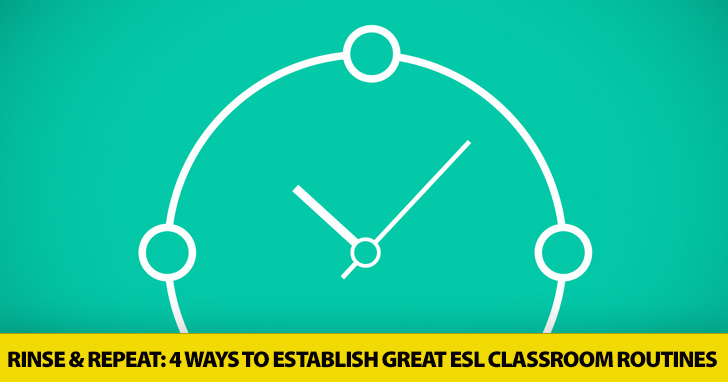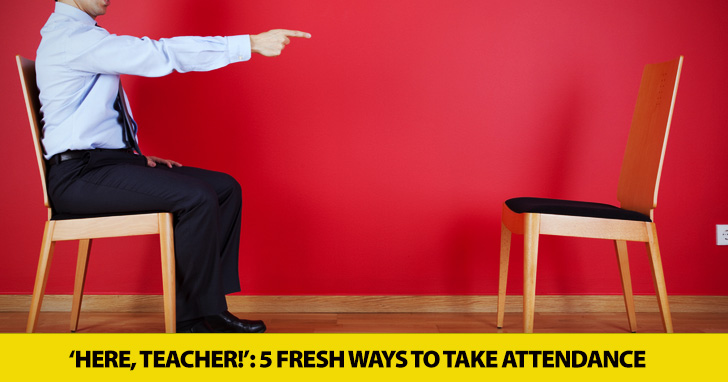Rinse and Repeat: 4 Ways to Establish Great ESL Classroom Routines


They’re efficient and help speed things along, leaving more time for other things. But I sometimes find that my routines become too repetitious, even automatic, so that they don’t require independent thought and language production, two aspects of ESL teaching that I’ve really been focusing on.
Taking attendance is an example. This should probably be a very quick part of the class, where the students simply confirm that they’re in the room. Some teachers even do this silently, without the students knowing. Others have a quick call-and-response system in which their students are required to say only something very simple:
| Teacher: | Carlos? |
| Carlos: | Yes. |
| Teacher: | Wendy? |
| Wendy: | Here. |
And so on. But it occurred to me that, like almost any other classroom situation, taking attendance was an opportunity for practice, and that I could, with a little thought, wring out some language production from this apparently routine (perhaps even tedious) moment. It need not be an automated, mindless repetition, but a warmer activity, the first chance of the day to bring a sentence or two of English from my students.
It is also a really good way to learn your students’ names; listening to them produce a few sentences is far more memorable than simply hearing a bland, ‘Yes!’ in response to their name. Just as importantly, the students can learn each other’s names more effectively, helping to break down one of those initial barriers to communication. Here are some possible methods:

Asking a simple question helps break the ice, and provides a chance for the students to learn more about each other, especially if they’re a new class. Here’s an example from during one of my intermediate classes during a brutal winter in Boston; the students were almost all from South America:
| Teacher: | Jose? |
| Jose: | Here, teacher. |
| Teacher: | Good morning, Jose! How was your trip to school this morning? |
| Jose: | Was OK. A little long. |
At this stage, the teacher could ask a follow-up question or (and this is always my preference) the students could do it. I find that gestures encourage quick, short questions like these very efficiently.
| Samantha: | And how did you get to school? |
| Jose: | By bus. Number fifty-seven. |
| Teacher: | Ah, the famous fifty-seven. Did anyone else take the bus to school this morning? |
| Others: | Yes / Was slow / Is terrible |
| Teacher: | Sorry, guys. Our bus system really isn’t great. OK, who’s next… Martin? |
| Martin: | Here, teacher. |
| Teacher: | How are you doing, buddy? |
| Martin: | OK, I guess. Little cold. |
Again, this is an opportunity for a follow-up question. In this case, I asked it:
| Teacher: | Yeah, no kidding. Anyone know the temperature right now? |
| Class: | (Checking phones) Erm… / Is cold! / Is freezing! |
| Martin: | Minus three Celsius. |
| Samantha: | Impossible! |
| Teacher: | Oh, I can believe that. Is this the coldest you’ve ever been? |
| Class: | Yes / Nearly. |
| Teacher: | OK, that leaves us with… Marianna. (Silence) |
| Samantha: | Is absent. |
| Teacher: | Really? Anyone know where she is? |
This may seem like overkill, but if I see a practice opportunity, especially for language we’ve recently covered, I tend to seize upon it:
| Class: | No / (shaking heads) |
| Teacher: | Where could she be? (seeing a chance for conditionals practice) |
| Jose: | Maybe is late. |
| Teacher: | ‘Maybe is late’… Can we improve on that, guys? |
| Martin: | She might be late. |
| Teacher: | (Thumbs up to Martin, gestures for Jose to try again) |
This led to a few more speculations as to the whereabouts of Marianna, and then we pushed onto the class content itself. A simple matter of confirming my students’ presence became a practice opportunity, the chance to confirm some information and exchange opinions, and suddenly a whole range of language was being produced.
A nice way to begin class is to write an incomplete sentence on the board, take attendance, and have each student complete the sentence. In this example, I wrote, “I’m happy today because…”:
| Teacher: | Jorge? |
| Jorge: | Here, teacher. I’m happy today because it’s not snowing! |
| Teacher: | Yeah, me too! Marianna? |
| Marianna: | I’m here, teacher. And I’m happy today because it is my mother’s birthday. |
| Teacher: | Happy birthday to your mom! Susan? |
| Susan: | Here, teacher. And I’m happy today because I am with my friends. |
| Teacher: | That’s nice, Susan, thanks… |
It’s never a bad time to practice question forms.
| Teacher: | Margaret? |
| Margaret: | I’m here. Erm… What did you have for dinner last night? |
| Teacher: | Jorge? |
| Jorge: | Here, teacher. I had a burger and fries at Five Guys. |
| Teacher: | Oh, yeah. Good burgers. And your question? |
| Jorge: | How did your parents meet? |
| Teacher: | Nice question! Marianna? |
| Marianna: | I’m here, teacher. They met in high school at a dance. |
| Teacher: | Romantic! Your question? |
Eventually, when the students habituate asking a question after their response, all that’s needed is a reminder gesture (at most) for this section of the class to proceed very smoothly, and produce lots of great language practice.
The simplest method would be to read down your class list and check off each name as you go. But I believe that spontaneity and variety both help retain the students’ interest and reinforce the importance of continuously paying attention. Here are some alternative ways to use your list:
I think it’s important to demonstrate the flexibility of English by showing the students some of the multiple possible ways of asking a given question.